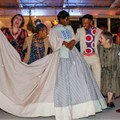Katekani Moreku: A rising star in sustainable fashion

Moreku has just completed his final year of fashion design at Durban University of Technology, but his resourceful approach to upcycling textiles into striking new garments has drawn praise from supporters of the slow fashion movement.
He's already scooped the Student Award at the Twyg Sustainable Fashion Awards as well as a MEC Recognition Award for Eco-Friendly Fashion from the KZN Economic Development, Tourism & Environmental Affairs.

Just recently, the young designer showcased his range at the inaugural Cape Town Resort Collection, an event conceptualised by the Gavin Rajah Concept company, in partnership with Pick n Pay Clothing. Moreku appeared alongside veteran fashion brands like Jenni Button, Gavin Rajah and Habits.
Here, Moreku shares his journey to design, the inspiration behind his work and his thoughts on the growing importance of sustainable fashion.
Share with us a bit about your life before fashion. Where did you grow up and what inspired you to become a designer?
I was brought up in a small village called Welverdiend in Bushbuckridge in the north east part of South Africa. Growing up I had no desire to become a fashion designer as Welverdiend is not a place where art and design are considered career options.
Like most kids in my community, my imagination only allowed me to dream as far as going into a “secure career ” that will help generate enough money to stabilise poverty, regardless of whether you are good at it or even like the career.
After studying electrical engineering for two and a half years and having a job I despised, I decided to go back to school and study something I’d appreciate. A close friend of mine suggested fashion because they liked the way I dress, and the rest is history.

How would you describe the Katekani Moreku aesthetic?
Katekani Moreku is a brand that accentuates out-of-the-box thinking and the countenance of inimitable individuality. It is bold and unconventional, not enthused by popular opinion. It is a modern representation of the SePulana culture and the decolonisation of South African fashion.
What drew you to be involved in the Cape Town Resort Collection this year?
I was scouted by Gavin Rajah as a young emerging designer whom they would like to give an opportunity to, and I was happy to take up the opportunity.
Tell us about your Cape Town Resort Collection range. What was the inspiration behind your designs and fabric choices?
The range is inspired by my SePulana culture and by the South African artist Walter Battiss’ method of borrowing elements from other art forms. As part of the traditional attire, the SePulana culture combines scraps of fabric and plastic material; I just used my imagination to create a modern attire for the SePulana culture.


You’re known for your creative upcycling of materials. What sparked your interest in this, and why do you believe it to be a valuable approach in the fashion industry today?
I gained an interest in sustainable fashion in varsity when I learned about fashion’s major contribution to pollution globally. Upcycling of materials is something that came naturally from the SePulana culture that I was brought up within, it just worked well with my love for playing devil’s advocate, and it allows me to be innovative and offer a different take on fashion.
I believe with this approach we can retrace our steps to sustainable living, this helps recognise the importance of sustaining our African heritage and to limit the climate change catastrophe before it reaches an irreversible stage of disaster.
Your rise to success has been somewhat swift. What have been some of the highlights of your career so far?
My goal was to be able to create a collection and tell a story through it, everything that happened after... everything I learned to create is a big highlight of my career.
But to name a few moments that really stood out for me, I was happy to be one of the young designers who were selected and invited to attend the Condé Nast International Luxury Conference in Cape Town this year. I was awarded the Student Award at the Twyg Sustainability Awards and I also received a MEC Recognition Award for sustainable fashion from the KZN Economic Development, Tourism & Environmental Affairs.
These awards reassured me that I am on the right track and I should keep doing what I do.
Who are some of your favourite local designers right now?
My favourite designers probably change every day. Today I woke up with an appreciation for the work of Thebe Magugu, Amanda Laird Cherry, Masa Mara and Anmari Honiball.
How do you think the South African fashion industry at large can better support young, talented designers like yourself?
The South African fashion industry should constantly create larger platforms that help young designers to gain access into the industry and to connect us to industry people. It is difficult to break through as a young designer if you are not exposed to proper channels where young talent can mature accordingly.












